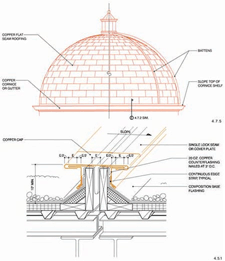Going by the Book

It's still called a handbook, although some in the building community might refer to it as "the Bible." And it's still available in printed form - should anyone still want to order it that way.
But over the past two decades, the Copper in Architecture Design Handbook has transformed itself time and again according to the technology of its day. Along with format changes to keep pace with the advent of computers, the content has also seen numerous updates to keep pace with construction and design practices.
This comprehensive architectural guide to installing all manner of copper building materials remains an industry standard, a dependable and familiar desktop companion for architects, builders, installers and other construction practitioners. Today, however, "desktop" has an entirely new meaning.
Conceived by the Copper Development Association (CDA), the engineering and market development arm of the copper and brass industry in the United States, in cooperation with the Canadian Copper & Brass Development Association (CCBDA), the handbook was initially printed in 1991. The print version included a set of diskettes containing computer-aided design, or CAD, detail drawings used by architects, engineers and draftsmen. As time and technology advanced, the entire handbook-digital illustrations and all-was transferred to a single CD-ROM for even greater convenience.
 High-resolution version of this photo.
High-resolution version of this photo.Recently, the complete contents were made available on the CDA website, www.copper.org, as digital PDF or "portable document format" pages for the ultimate in user convenience -and user savings (the easy-to-download PDF version is available at no cost). The detail drawings can also be downloaded from the CDA website as DWG files for use with CAD programs.
"It has been an evolution," says Wayne Seale, a CDA regional manager who coordinates the organization's national architectural support program from his home base in Seattle, Washington. "If you make it easy for architects and others to specify and detail materials, they are more likely to use them, and Copper in Architecture is very useful. Architects need it. Installation contractors need it. We get calls for it all the time."
Until the changeover to the online version, CDA published and distributed some 3,000 copies in one format or another. For more information about CDA publications, or to order your copy, visit our Publications section or call us at 212-251-7200.
Also in this Issue:
- Going by the Book
- Greening Fire Sprinkler Systems with Copper
- What Would Al Gore Choose?
- Copper's Design Potential Highlights Architectural Seminars
- Return to Glory
